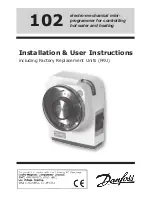
Sequence of operation
VAV Zone II Controllers
CARRIER CORPORATION ©2019
Installation and Start-up Guide
All rights reserved
49
Zone airflow control
The VAV Zone II provides pressure-independent zone temperature control by modulating its damper actuator to
control the flow of primary air into the zone. The controller uses PID control to calculate the airflow setpoint based
on the air source mode and the difference between the zone’s temperature and setpoints.
The air source mode determines if the primary air can meet the zone’s need. If the zone controller is in a linked
system, the air source mode is determined by the air source. If the zone controller is stand-alone or if linkage
communication fails, the mode is determined by the controller's SAT sensor. See
Air source mode determination
(page 57). If the air source mode is the same as the zone’s required mode, the damper is positioned so as to
modulate the airflow setpoint between the mode’s configurable minimum and maximum airflow based on the
occupancy status of the zone. This minimum insures sufficient minimum airflow at the air source and sufficient
ventilation to the zone during occupied periods.
Single duct with reheat
– The
Auxiliary Heat Min Airflow
allows an increase of primary airflow across the
terminal’s ducted heating coil when the terminal operates its local heat. This provides the ability to lower the
cooling minimum airflow limits while providing the necessary airflow when the terminal is heating to ensure design
load conditions and electric heater minimum airflow.
VAV Reheat
– Applicable only to single duct terminals with modulating or SCR Electric heat, when set to enable
and reheat is required, the heating device is sequenced first to obtain the
Maximum Heating SAT
before any
increase in airflow. When reheat starts, airflow is maintained at the configured minimum occupied value. Once the
Maximum Heating SAT
is reached and, if a further increase in heating capacity is required, then the airflow is
increased as needed up to the configured
Auxiliary Heat Min Airflow
value.
Parallel fan terminals
– The controller's
Parallel Fan On Value
determines when the fan turns on to increase
airflow at the zone’s diffusers and prevent cold air from dumping into the zone. This is achieved by increasing the
volume and temperature of the air exiting the diffusers. If the zone’s airflow control setpoint falls below the
Parallel Fan On Value
, the parallel fan turns on to mix ceiling plenum air with the primary air to increase total
airflow and ventilation to the zone. The fan turns off when the airflow control setpoint rises above this value. If the
zone requires heat while the AHU fan is off, the damper will close while heating is active to prevent reverse flow
out through the terminal inlet.
The fan also starts in Heat mode if the zone is configured for ducted heat as described in
Zone reheat control
(page 50).
Series fan terminals
– The fan turns on when the air source fan is on as determined by Linkage or in stand-alone
operation by airflow monitoring (the fan is determined to be ON if the measured airflow increases above 20% of
the
Cooling Max Airflow
or if the measured airflow is greater than 50% of the current airflow setpoint). When the
air source starts operation, there is a fan start delay on transition to occupied, based on the
Power Fail Start
Delay
. The terminal's damper fully closes and, after a 15 second delay, the fan starts. This prevents the fan from
rotating backwards. Therefore, each series fan box should have a unique power fail restart delay to avoid closing
all dampers simultaneously.
Damper Actuator(s)
– The VAV Zone II's 45 in/lb (5 Nm) actuator has a 154 second full travel time for 90°
operation. For field retrofit applications, the actuator can be adjusted for a damper stroke between 30° and 90°,
and it can be configured to move clockwise (default) or counterclockwise.
If the built-in actuator's torque is insufficient for large damper applications, the VAV Zone II's analog output can
drive an external, 0-10 volt, high-torque actuator.
Summary of Contents for VAV Zone II
Page 109: ......
















































